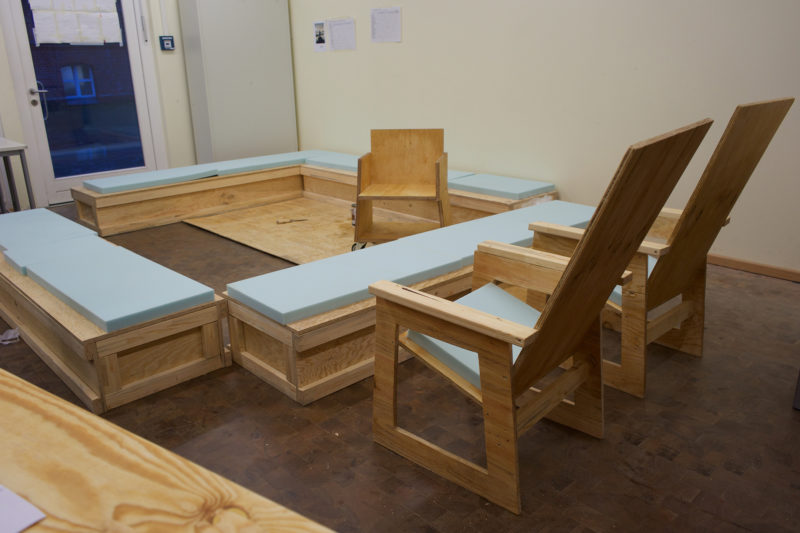Lernraum
Research on the learning space
ConstructLab was invited by the Bauhaus Agents to accompany the creation of a learning space in the Paula Fürst School by mediating the design process, guiding the conceptual and aesthetic development and producing furniture for the space in an open workshop format with the pupils.
The question of how we learn also includes the question of where we learn. The learning space is not only the place where things happen, but also an actor – it is not only the place where we learn, but part of the learning process itself. Based on this assumption, we understand the learning space as parallel processes of space, group and knowledge formation. We want to explore various activities of learning – including everyday activities – by practising them: the act of understanding, defining, making, simulating, negotiating, trying and observing. We try to deal theoretically and practically with the needs of learning, also because our imagination is often based on practical creativity, unfolds interdisciplinary and shows its greatest effect in cooperation with future or potential users.
With its interdisciplinarity, constructLab operates in the tradition of the Bauhaus, understanding the design question as a large, open field in which ideas, practice and production can be combined
In the Paula Fürst School, the creative process begins with the introduction of the classical means of design: The body functions as a scale – measurements are taken, documented and recorded. A feasibility study reveals the problems of everyday life together: Who buys coffee when everyone is gone, who decides how loud the music can be played and how to agree on a wall colour? All these questions are essential when it comes to designing one’s own learning space. The solutions can only be found by starting to put the ideas into practice. Thereafter, the pupils simulate situations in which they use and share common spaces and transfer them to the art rooms of the Paula Fürst School. They form opinions, collect thoughts, make choices and confront their ideas in conversation. Over the course of a week, the pupils of the upper grades work together with elementary school pupils and the constructLab team in the school’s workshops and produce the equipment for a room that will be freely available to them in the future. The division of labour works like in a factory: various workshops are responsible for parts of the greater common project – the wood workshop, the model workshop, the textile workshop and the ceramics workshop. The division of labour functions like in a factory: various workshops assume responsibility for parts of the major common task – the wood workshop, the model workshop, the textile workshop and the ceramics workshop. The individual areas work on the qualities inherent in their materials and at the same time always relate to one another: the wooden furniture offers the surface into which the ceramic tiles are embedded, the upholstery lies on the seat of the chair, but the dimensions of the wooden furniture must also be oriented to the dimensions of the textile. In addition to production, the focus is on learning, finding consensus and realising. In this case, however, the usual artistic freedom from art lessons must be put aside in order to achieve a common goal and the design of functional and intelligent furniture.
Until: May 1, 2018
- Licia Soldavini
- Mascha Fehse
- Bastian Braun
- Samuel Carvalho
- Patrick Hubmann
- Maria Garcia
- Nina Nikic
- Claudia di Falco
- Bauhaus Agenten, Anja Edelmann
- Bauhaus-Archiv / Museum für Gestaltung
- Catrin Schmitt
- Paula-Fürst-Gemeinschaftsschule
- Johanna Lutz, Madlen Schmitz, Kirsten Zenns















Image Credits: Catrin Schmitt